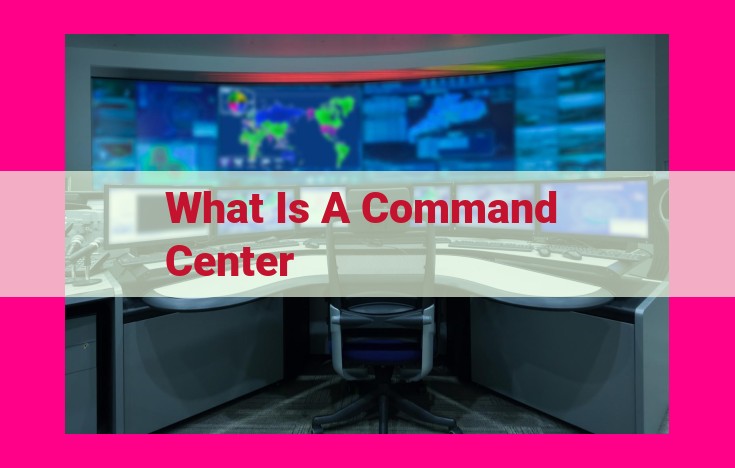Mission-Critical Command Centers: Optimizing Incident Response And Business Continuity

A command center is a central facility that integrates infrastructure, personnel, processes, data, and external support to monitor and manage critical incidents and operations. It utilizes advanced technology, including data centers, network infrastructure, visualization platforms, and incident management systems. Skilled operators, analysts, and decision-makers work together to execute incident response plans, security monitoring, and business continuity procedures. Data analysis, reporting, and external collaboration provide insights for informed decision-making. Command centers enhance operational efficiency, improve situational awareness, and ensure rapid and effective response to emergencies and disruptions.
Infrastructure and Technology: The Backbone of Command and Control Centers
Introduction:
In today’s rapidly evolving digital landscape, command and control centers play a vital role in ensuring seamless operations and effective decision-making. _**The backbone of these centers lies in the infrastructure and technology that empowers them to monitor, analyze, and respond to critical events._
Data Centers: The Nerve Center
Command and control centers rely on robust data centers that house the colossal amounts of data essential for decision-making. These state-of-the-art facilities provide secure storage and efficient processing capabilities, ensuring uninterrupted access to critical information.
Network Infrastructure: The Information Highway
A reliable and high-speed network infrastructure is crucial for connecting various components of the command and control center. This infrastructure includes switches, routers, and fiber optic cables that enable seamless communication between sensors, workstations, and other devices.
Servers and Storage: The Data Powerhouse
Servers and storage devices provide the computational muscle for command and control centers. These powerful machines host command and control software and store vast amounts of operational data, including historical records and real-time event information.
Command and Control Software: The Brain of the System
Command and control software serves as the central nervous system of these centers. It integrates data from multiple sources, provides visualization tools for real-time situational awareness, and automates processes to streamline incident response and decision-making.
Visualization Platforms: Seeing the Big Picture
Visualization platforms empower operators to comprehend complex data and identify patterns. They present dashboards and reports that display critical metrics, event timelines, and geospatial information, facilitating a comprehensive understanding of situational dynamics.
Remote Monitoring and Management Tools
Command and control centers often require remote monitoring and management capabilities. These tools enable administrators to access and control systems remotely, ensuring continuous operation and quick troubleshooting in case of emergencies.
Incident Management Systems: The First Responders
Incident management systems are the indispensable tools for coordinating and managing critical events. They provide a centralized platform for tracking incidents, assigning resources, and communicating with stakeholders, ensuring a swift and effective response to any situation.
The infrastructure and technology that underpin command and control centers are essential for ensuring their effectiveness and reliability. By investing in robust and scalable solutions, organizations can empower their teams with the tools they need to make informed decisions, respond迅速 to emergencies, and safeguard critical operations.
Personnel: The Human Element of Command and Control
In the intricate tapestry of command and control centers, the human element weaves an indispensable thread. It is through the expertise, dedication, and teamwork of individuals that these centers operate with precision and efficiency.
Command Center Operators:
The front-line responders, command center operators are the eyes and ears of the organization. They monitor systems, receive alerts, and initiate the necessary actions to mitigate incidents promptly. Their sharp attention and quick reflexes ensure that every incident is handled with the utmost care and efficiency.
System Administrators:
The unsung heroes of the technical realm, system administrators toil behind the scenes to maintain the smooth functioning of the center’s infrastructure. They configure and update systems, ensure network stability, and resolve any technical glitches seamlessly. Their expertise empowers the center to operate without interruption, enabling optimal performance.
Network Engineers:
The guardians of the digital realm, network engineers design, implement, and manage the network infrastructure that connects the center to the world. They ensure that data flows reliably and securely, enabling real-time communication and information sharing. Their prowess keeps the lines of communication open, fostering collaboration and enabling efficient incident response.
Security Analysts:
With vigilance ever-present, security analysts safeguard the center from cyber threats and malicious actors. They monitor network traffic, detect suspicious activities, and implement robust security measures to protect sensitive data and systems. Their unwavering vigilance ensures that the center remains a safe haven in the face of ever-evolving threats.
Analysts and Decision-Makers:
The brains behind the operation, analysts and decision-makers provide strategic guidance and informed recommendations. They interpret data, identify trends, and make critical decisions that shape the direction of the center’s operations. Their expertise empowers the organization to navigate complex challenges and emerge victorious.
Processes and Procedures: The Guide for Smooth Operations
- Emphasize the necessity of establishing clear incident response plans, security monitoring and mitigation processes, compliance and audit protocols, emergency management, disaster recovery, business continuity, and cybersecurity response procedures for effective command and control.
Processes and Procedures: The Guide for Smooth Operations
In the dynamic world of command and control centers, seamless operations hinge on well-defined processes and procedures. These serve as the blueprint for efficient responses to critical incidents, ensuring that every action is executed with precision.
Incident Response Plans
Establishing a comprehensive incident response plan is paramount. It outlines the steps to be taken, roles and responsibilities, communication protocols, and escalation procedures in the event of an emergency. By having a clear plan in place, the command center can respond swiftly and effectively, minimizing the impact and potential damage.
Security Monitoring and Mitigation
Proactive security measures are crucial to protect command and control centers from cyber threats. Establishing robust security monitoring and mitigation processes allows the team to detect and respond to threats in real-time. This includes regular security audits, vulnerability assessments, and incident response protocols.
Compliance and Audit Protocols
Compliance with industry standards and regulations is essential for maintaining the integrity and reliability of command and control operations. Adhering to compliance and audit protocols ensures that the center meets regulatory requirements and best practices. It also helps to build trust and credibility with stakeholders.
Emergency Management and Disaster Recovery
Emergency management and disaster recovery plans are critical for ensuring continuity of operations during unexpected events. These plans should outline the actions to be taken in response to natural disasters, power outages, or other disruptions. They should also include procedures for data backups, evacuation, and communication with external agencies.
Business Continuity
Business continuity plans ensure that the command and control center can continue to operate in the event of a major disruption. These plans include measures for maintaining essential services, relocating operations, and coordinating with backup facilities. They help to minimize downtime and ensure a smooth transition during critical situations.
By implementing these processes and procedures, command and control centers can establish a framework for efficient and reliable operations. It empowers operators to respond to incidents quickly, maintain security, ensure compliance, and navigate disruptions with confidence.
Data and Reporting: The Foundation for Informed Decision-Making
- Discuss the importance of utilizing internal and external data sources, leveraging real-time and historical data, tracking performance metrics and KPIs, setting up alerts and notifications, and adhering to standards such as ISO 22301:2012 and the NIST Cybersecurity Framework for data management and reporting in command and control centers.
Data and Reporting: The Foundation for Informed Decision-Making in Command and Control Centers
In the fast-paced world of command and control, access to reliable and timely data is paramount for informed decision-making. Command and control centers serve as the nerve centers of organizations, where data from various sources is aggregated, analyzed, and presented to stakeholders.
Leveraging Internal and External Data
Data is the lifeblood of command and control operations. Internal data provides valuable insights into organizational processes, performance indicators, and areas for improvement. _External data supplements this internal data by providing context and industry benchmarks. By combining both sources, command and control centers gain a comprehensive view of their operations and the external environment they operate in.
Real-Time and Historical Data
Command and control centers require both real-time and historical data to make effective decisions. _Real-time data allows operators to monitor critical events as they unfold, enabling them to respond swiftly and appropriately. _Historical data provides a foundation for trend analysis, forecasting, and performance evaluation. By combining these two data types, command and control centers can gain a deeper understanding of patterns and trends, improving decision-making capabilities.
Tracking Performance Metrics and KPIs
Measuring performance is essential for continuous improvement. Command and control centers track key performance indicators (KPIs) to assess the effectiveness of their operations. By establishing targets for these KPIs and monitoring progress over time, organizations can identify areas for optimization and ensure that command and control functions are meeting their objectives.
Alerts and Notifications
Alerts and notifications play a crucial role in keeping command and control centers informed of critical events and potential risks. By setting up thresholds and triggers, these systems can automatically notify operators of important changes or deviations from normal operating parameters. This enables timely intervention and minimizes the potential impact of incidents.
Adherence to Standards
To ensure data management and reporting are conducted consistently and effectively, command and control centers adhere to industry standards such as ISO 22301:2012 and the NIST Cybersecurity Framework. These standards provide best practices for data collection, analysis, and reporting, ensuring that decision-makers have access to high-quality and reliable information.
External Collaboration and Support: Empowering Command and Control
In the dynamic landscape of command and control, external collaboration plays a pivotal role in augmenting operational efficiency and effectiveness. By forging partnerships with third-party vendors, organizations can gain access to specialized expertise, cutting-edge technologies, and cost-effective solutions. These vendors offer a wide range of services, including infrastructure management, data analytics, and incident response support, enabling command centers to focus on their core competencies.
Furthermore, partnering with service providers can enhance network connectivity, data storage, and cloud computing capabilities. These providers ensure reliable infrastructure, reduce downtime, and provide flexible scalability options to meet changing operational demands. By outsourcing non-core functions, command centers can free up resources and improve overall performance.
Collaboration with collaborating agencies or organizations fosters knowledge sharing, best practice exchange, and mutual support. Sharing experiences, lessons learned, and incident management protocols enables organizations to stay abreast of industry trends and adapt to emerging threats. Joint exercises and simulations strengthen inter-agency coordination and enhance overall preparedness.
Engaging with regulatory bodies provides valuable insights into industry standards, compliance requirements, and best practices. By aligning with regulatory guidelines, command centers can demonstrate accountability and enhance public trust. Collaborating with regulatory bodies also facilitates information sharing and access to resources, such as training programs and advisory services.
In conclusion, external collaboration and support are essential pillars of a robust command and control ecosystem. By leveraging partnerships with third-party vendors, service providers, collaborating agencies, and regulatory bodies, organizations can strengthen their operational capabilities, enhance data management and reporting, improve resilience, and ultimately achieve their mission-critical objectives.





